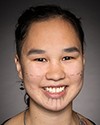Kwe kwe. Unnusakkut. Tansi. Hello.
Hello.
Before I begin, I want to acknowledge that in Ottawa, I'm on the traditional territory of the Algonquin Anishinabe people.
First and foremost, I do want to say a few words for the communities, families and friends impacted by the tragic news of the children whose remains were recently found at the former Kamloops residential school located on the traditional territory of the Tk'emlúps te Secwe̓pemc people.
I'd like to thank the members for their continued advocacy and echoing indigenous voices here in Parliament.
While this discovery has shocked and disturbed the nation, for indigenous peoples across the country, these findings are deeply painful, traumatizing and triggering, although they are not surprising, particularly for the indigenous peoples who have known this truth for far too long.
Our thoughts remain with the families and communities impacted not only by this discovery but by the residential school system. It is essential that we respect and continue to respect the privacy, space and mourning period of those communities that are collecting their thoughts and putting together their protocols as to how to honour these children.
We recognize that there is a continuing need for psychological wellness services associated with childhood and intergenerational trauma. We will continue to work with our partners and the communities, first and foremost to ensure adequate access to appropriate services.
The survivors and the families affected by the indigenous residential schools system have access, among other things, to the national Indian residential schools crisis line if they need it. The Indian residential schools resolution health support program also offers access to elders, to traditional healers and to other appropriate forms of cultural and emotional support, as well as to professional mental health counselling.
In addition, all indigenous peoples can access the hope for wellness help line, online or by phone, to get help. During the COVID-19 pandemic, we are offering additional support so that indigenous communities can adapt and broaden mental health services.
We also recently announced $597.6 million over three years for a mental health and wellness strategy based, of course, on the distinct characteristics of the First Nations, the Inuit and the Métis Nation. The strategy includes continuing support for former residential schools students and their families. It will be based on existing competencies and will help to fill gaps and respond to the existing, emerging and future needs of indigenous communities.
I'm here today to answer your questions on the supplementary estimates (A) for 2021-22 and to provide you with an update on continuing efforts to confront the evolving COVID-19 pandemic. I will also answer any other questions that the committee chooses.
For this year, the total authority will be $18.9 billion, which reflects a net increase of $5.4 billion. This includes support for initiatives such as funding for COVID-19 responses, including, notably, $760.7 million for the indigenous community support fund that has been so welcomed, $64 million for the continuation of public health responses in indigenous communities and $332.8 million for indigenous communities affected by disruptions to their revenue due to COVID-19, which we announced, made official and launched yesterday.
The net increase for the supplementary estimates (A) also includes $1.2 billion for out-of-court settlements to advance Canada's overall commitment to reconciliation by paving the way to a more respectful and constructive relationship with indigenous peoples.
It also includes $1.1 billion for child and family services to support a proactive agreement on a non-compliance motion before the CHRT. The funding is crucial. Since the CHRT issued its first order for Canada to cease its discriminatory practices in 2016, we have been working with first nations leaders and partners to implement the tribunal's orders, and we are in compliance. The $1.1 billion will go to communities that are engaged in activities that prevent the apprehension of kids and contribute to the transformation of the system that has been so broken.
Let me be clear once again. We share the same goal: First nations children historically harmed by the child welfare system will receive fair, just and equitable compensation. The government is not questioning or challenging the notion that compensation should be awarded to first nations children who were harmed by the historical discrimination and underfunding of the child welfare system. The question is not whether we compensate; it is a question of doing so in a way that is fair, equitable and inclusive of those directly impacted.
To this end, we have already consented to certification of the consolidated class action filed in the Federal Court by the Assembly of First Nations and Councillor Xavier Moushoom regarding the same children who were harmed by the system, as contemplated by the CHRT. Furthermore, we are currently in mediation with the partners, but as is set out in the mediation agreement, those discussions will remain confidential out of respect.
We remain committed to providing first nations children access to the necessary supports and services in partnership with indigenous peoples. To that effect, it's important to note that 820,000 claims under Jordan's principle have been processed since 2016, which represents close to $2 billion in funding.
Most notably, in January 2020, An Act respecting First Nations, Inuit and Métis children, youth and families came into force. It is key to this conversation in transforming the relationship, responding to the calls to action and setting a new way forward. Indigenous governments and communities have always had the inherent right to decide things that people like me take for granted; that is, what is best for their children, their families and their communities. The act provides a path for them to fully exercise and lift up that jurisdiction.
As a result of this work led by indigenous communities, two indigenous laws have now come into force under the federal law, the Wabaseemoong Independent Nations law in Ontario and the Cowessess First Nation Miyo Pimatisowin Act in Saskatchewan. In each of these communities, children will have greater opportunity to grow up and thrive immersed in their culture and surrounded by loved ones.
I will now move on to an update on COVID-19.
Throughout the pandemic, and still today, Indigenous Services Canada has been aware of the particular vulnerability of indigenous communities to the virus.
From the outset, we knew that immediate, decisive measures were necessary to protect the communities as best we could. Our absolute priority was the safety, health and well-being of the First Nations, the Inuit and the Métis.
However, without the dedication and determination of all of the leaders of those communities, none of that would have been possible. I want to thank them for their continuous work over the last year, in particular in encouraging the members of their communities to get vaccinated.
With respect to vaccine roll-out, as of June 7, 687 indigenous communities had campaigns underway. In total, that corresponds to 540,581 doses administered, including first and second doses.
This means that 41% of eligible people aged 12 and over in the communities or living in the territories have received two doses of the vaccine. This is crucial in the communities where the population is predominantly young.
In addition, 80% of people have received a first dose, and if we consider those aged 12 and over, we are talking about 72%. So this is tremendous progress.
With respect to the number of cases, as of June 9, in First Nations communities, we are aware of 761 active cases, which is, fortunately, a decline from the previous week. That brings us now to just about 30,568 confirmed cases of COVID-19. Of those, 29,459 people have recovered, and, tragically, 348 others have died.
I see that perhaps that you're flagging me, Bob, or do I have a couple of minutes?






